How to Determine the Authenticity of Gemstones
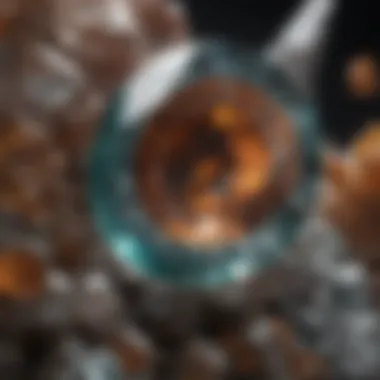
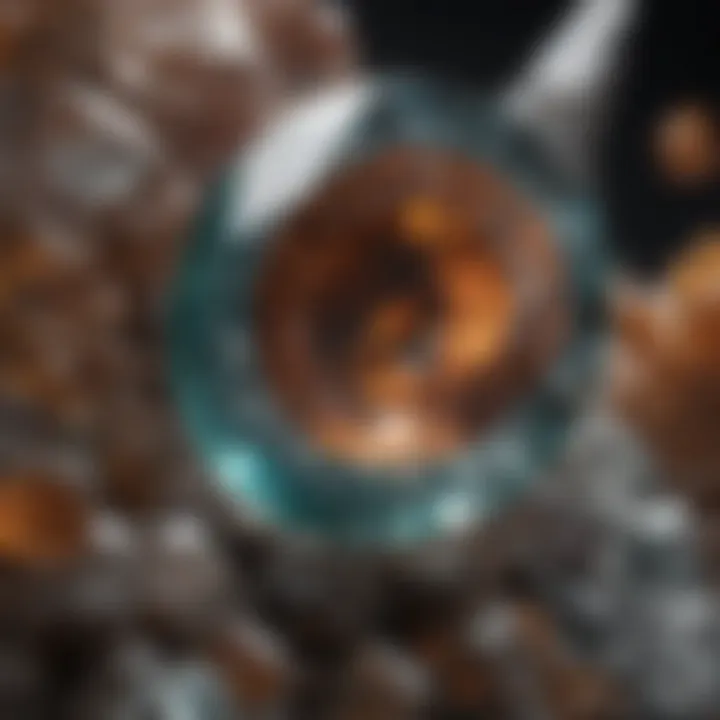
Intro
In the world of gemstones, authenticity is king. For collectors, hobbyists, and investors alike, distinguishing between a genuine stone and an expertly crafted imitation can be a daunting endeavor. With the marketplace continuously evolving and the proliferation of sophisticated fakes, the importance of knowing how to assess gemstone authenticity has never been more paramount. This guide will travel through various avenues, enabling readers to identify authentic gemstones using methods ranging from the simplest visual checks to advanced gemological assessments.
As we embark on this journey, expect to discover the multifaceted layers of gemstone evaluation, including physical characteristics, testing practices, and the financial implications of the choices made in this unique realm. For enthusiasts looking to deepen their understanding, it’s these very insights that can separate the diamond from the dust.
Featured Collectible of the Month
Overview
Each month, we will shine the spotlight on a gemstone that has captured the hearts of collectors — the Tanzanite. Known for its mesmerizing blue-violet hues, Tanzanite is mined solely in Tanzania, making it a geographically unique collectible. This gemstone's distinct coloring can range widely, sometimes evoking deep ocean blues and other times, soft lavender shades that catch the light beautifully.
Historical Significance
Discovered only in the 1960s, Tanzanite quickly ascended to fame and became a symbol of luxury and rarity. Its rapid rise in popularity is tied not just to its beauty but also to its backstory. As the only known source lies beneath the conglomerate hills of Tanzania, this gemstone encapsulates the essence of a fleeting moment in geological history. Its finite supply makes it an intriguing investment, further enhancing its appeal to those in the market.
Identification Techniques
Visual Characteristics
When evaluating gemstones, the initial assessment often begins with a keen eye. Here are some visual characteristics to keep in mind when determining authenticity:
- Color: Genuine gemstones exhibit rich, deep colors. Be wary of overly vibrant or uniform shades, which can indicate synthetic origins.
- Inclusions: Natural stones often contain tiny imperfections known as inclusions. These distinct marks can provide valuable authenticity cues. Conversely, synthetic stones usually sport clarity.
- Cut: The craftsmanship involved in cutting the gemstone can hint at authenticity. Poorly cut stones might be signs of imitations.
Resources for Identification
No single method can guarantee accuracy in identifying genuine gemstones, but various resources can aid you in your quest:
- Appraisers and Gemological Institutes: Professional appraisers and entities like the Gemological Institute of America (GIA) are reliable sources for stone evaluation.
- Online Communities: Platforms like Reddit and Facebook host groups dedicated to gemology where collectors share experiences and advice that can be invaluable.
- Books and Publications: A wealth of literature exists that discusses gemstone properties and identification techniques, such as "Gemstones of the World" by Walter Schumann, which can provide an excellent foundation for learning.
"The beauty of a gemstone lies not just in its appearance but also in its authenticity — something no imitation can replicate."
Foreword to Gemstone Authenticity
In the realm of gemstones, authenticity plays a crucial role. The market is flooded with both genuine stones and cleverly crafted imitations, making it vital for enthusiasts, collectors, and jewelers alike to discern between the two. With the rising value of gemstones, the stakes are high; purchasing a fake can lead not just to financial loss, but also emotional disappointment.
When discussing authenticity, it’s not just about determining if a stone is natural or synthetic. It's about understanding the full context—knowing the origin, treatment, and quality of a gemstone. Recognizing these factors not only provides insight into the value of the stone but also enriches the collector's experience overall. Furthermore, being informed helps individuals make educated decisions, allowing them to navigate through various markets with confidence.
Genuine gemstones often boast attributes that imitations lack—be it color depth, clarity, or even the way they refract light. By understanding these traits, one can engage more deeply with their collection. Notably, the importance of authenticity extends beyond monetary value; it can also tie into ethical considerations surrounding gemstone sourcing and environmental impact.
"The world of gemstones is not just about beauty; it’s about integrity and understanding what one invests in."
This section will cover the significance of recognizing authenticity, as it allows collectors to appreciate the true essence of their stones. Not only does it safeguard against deceitful sales, but it also promotes an overall culture of knowledge and respect within the gemstone community.
Understanding the Importance of Authenticity
The importance of authenticity in gemstones cannot be overstated. When you invest in a gemstone, you aren't just buying a pretty rock; you're buying an experience, a story, and in many cases, a legacy. Genuine gemstones hold their value over time, much like fine art or rare collectibles. On the contrary, imitations might look the part initially, but their value dwindles significantly once the truth comes to light. It becomes clear that a sound understanding of authenticity directly correlates with financial prudence.
Moreover, the digital age has heightened the importance of authenticity. Online marketplaces and auctions have made it easier to buy and sell gemstones, but they also make it simpler for scams to flourish. By identifying authenticity, gem enthusiasts cultivate trust in the community and marketplace, laying the groundwork for more secure transactions.
Common Myths About Gemstones
A myriad of misconceptions about gemstones can lead to poor decisions and misunderstandings. Among these myths, a few stand out as particularly pervasive:
- All cheap gemstones must be fake: Price alone is not a marker of authenticity. Real gemstones can sometimes be acquired at lower costs, especially if sourced directly from mines or during sales.
- All synthetic stones are inferior: While synthetic stones are created in labs, many possess identical chemical and physical properties to their natural counterparts. They may not have the unique inclusions or history that appeal to some collectors, but they can be just as beautiful and valuable.
- A certification always guarantees authenticity: While certification is helpful, it’s important to verify the credibility of the certifying entity. Not all organizations are equally reliable.
By debunking these myths, collectors can make informed choices, reducing the risk of being duped and enhancing their overall experience in the gemstone world. Awareness and knowledge are the best tools for navigating this beautiful yet complex landscape.
Visual Examination Techniques
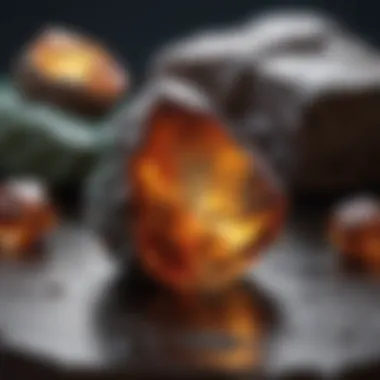
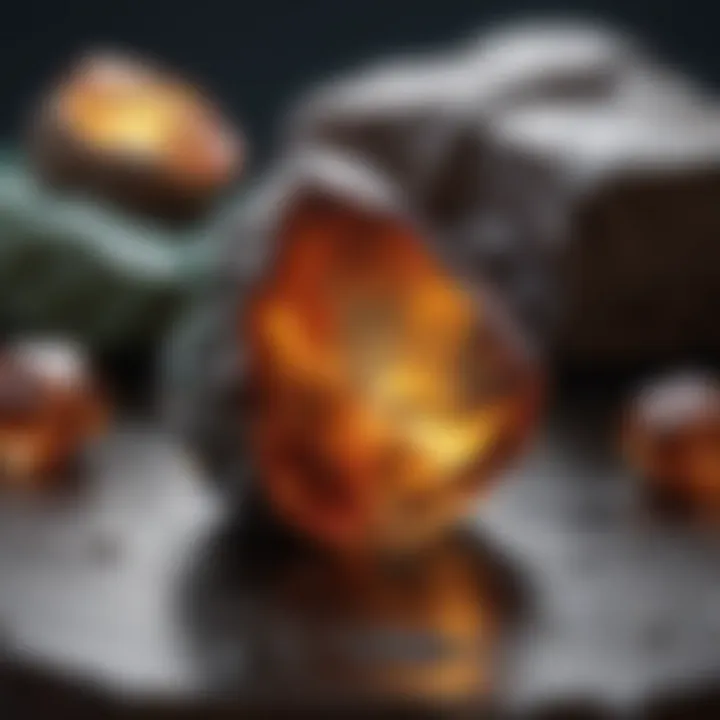
Visual examination techniques are foundational for identifying genuine gemstones. These methods allow gem enthusiasts to perform preliminary checks that can significantly narrow down the possibilities when assessing authenticity. Not only are these techniques accessible, requiring minimal tools and expertise, but they also lay the groundwork for more advanced evaluations. When employed correctly, these strategies can help individuals spot discrepancies that fake stones often display, providing an essential initial layer of scrutiny.
Assessing Color and Clarity
Color plays a crucial role in determining the authenticity of a gemstone. Each stone exhibits a specific spectrum of colors, with certain hues being more desirable or rare than others. For example, the deep blue of a sapphire stands out far more than a pale imitation.
When assessing color:
- Examine Under Various Lighting Conditions: Natural light is often the best for this, as artificial lights can skew perception.
- Look for Consistency: A genuine gemstone reflects color evenly throughout. If patches appear starkly different, it may indicate a fake.
- Profile Color Saturation: Assess how rich or muted colors are; vivid saturation often signals authenticity.
Clarity, on the other hand, reflects the presence of flaws within the gemstone. A perfectly clear stone can be striking, but many precious stones have natural inclusions, which can be a mark of authenticity. Therefore, inspecting clarity should also focus on whether inclusions are typical for the type of stone. As an example, emeralds frequently have inclusions, while a perfect emerald may raise red flags due to its rarity.
Identifying Inclusions and Flaws
Identifying inclusions and flaws involves a microscopic or magnified examination of the gemstone. Inclusions are small imperfections or foreign materials trapped within the stone during its formation. Recognizing these can help differentiate natural stones from synthetics. When scrutinizing for inclusions:
- Utilize a Loupe or Microscope: Even the simplest magnifying tools can create significant shifts in understanding.
- Familiarize with Typical Inclusions: Each gemstone type presents unique flaws; for instance, rubies may show needles structures, while diamonds may have carbon spots.
- Look for Bubbles: If a stone has bubbles within it, this can indicate it is synthetic or glass-based.
The presence of natural inclusions can contribute to the stone's character; a completely flawless gemstone is often too perfect to be natural.
Understanding Cut and Shape
The cut and shape of a gemstone significantly influence its brilliance and overall appeal. Cut refers to how well the gemstone has been shaped and polished, affecting how light interacts with it. A poorly cut stone may show signs of unevenness or dullness, raising concerns about its authenticity. Consider careful evaluation of:
- Symmetry and Proportions: Uneven facets or irregular proportions indicate potential fakes.
- Faceting Style: Real gems may have unique facet patterns not easily replicated in imitations.
- Overall Shape: Various gems have standard cuts (like cushion, round); deviations could suggest a lack of authenticity.
Investing time to assess cut and shape yields both aesthetic pleasure and essential clues about a stone's authenticity.
"Mastering visual examination techniques not only enhances your gemstone experience but also protects your investments, keeping imitations at arm's length."
Armed with these foundational skills, you establish the necessary groundwork for your gemological journey. This preparation ultimately leads you to a richer understanding of gemstones, guiding you toward authentic treasures.
Physical Properties Testing
For collectors, especially those new to the field, understanding physical properties can provide a framework to distinguish genuine gems from lesser-quality fakes. This often involves examining hardness and weight, among other attributes, which are foundational to gemology. Additionally, applying these tests can aid in assessing a stone’s overall value, which ties directly into market dynamics. With every facet examined, the path towards authenticity becomes clearer.
Hardness and Scratch Tests
One of the most straightforward yet effective methods for assessing a gemstone's authenticity is through hardness tests. The Mohs scale, ranging from talc (1) to diamond (10), serves as a reference point to gauge a gem's resistance to scratching. For example, if you drop a small quartz crystal onto a topaz stone, and the topaz scratches, it indicates that the topaz might be an imitation or a lower-quality specimen.
It's worth noting that many jewelers and collectors utilize tools like the scratch test kit. However, using common household items for a quick check often suffices. A cleverly simple approach might involve scraping the gemstone with an object of known hardness. If your stone scratches too easily or fails to scratch expected counterparts, that’s a red flag.
For instance, if a supposed sapphire can be easily marred with a common iron nail, the likelihood increases significantly that what you're holding isn't sapphire. Likewise, it's crucial to recognize that some synthetics might mimic hardness but fail on closer inspection with the right tools.
Density and Weight Checks
Another critical physical property in testing gemstone authenticity is density. Genuine gemstones generally have a specific weight that correlates with their composition. For example, diamonds possess a notable density that is difficult to replicate in fakes. Weighing a gemstone and comparing it to its expected weight based on size and type gives a clear indicator of its authenticity.
To perform a density test, a simple balance scale can provide insights. Weigh the stone first in air and then again while it’s submerged in water. By applying Archimedes’ principle, the difference offers a formula for calculating the stone’s density:
[ ]
This approach is not only straightforward but educative for enthusiasts looking to deepen their knowledge. It allows for hands-on learning and provides immediate insights into the property of the gemstone.
Understanding the physical properties of gemstones is like holding the key to a treasure trove; each test unlocks a piece of the puzzle, helping you unveil the mysteries behind those glittering stones.
As you engage in hardness and density tests, remember that the process is about building a deeper understanding of the stones you collect. It’s not just about spotting fakes; it’s about appreciating the true essence of gemstones in your collection.
Advanced Gemological Assessments
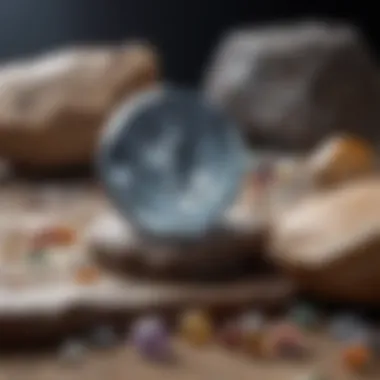
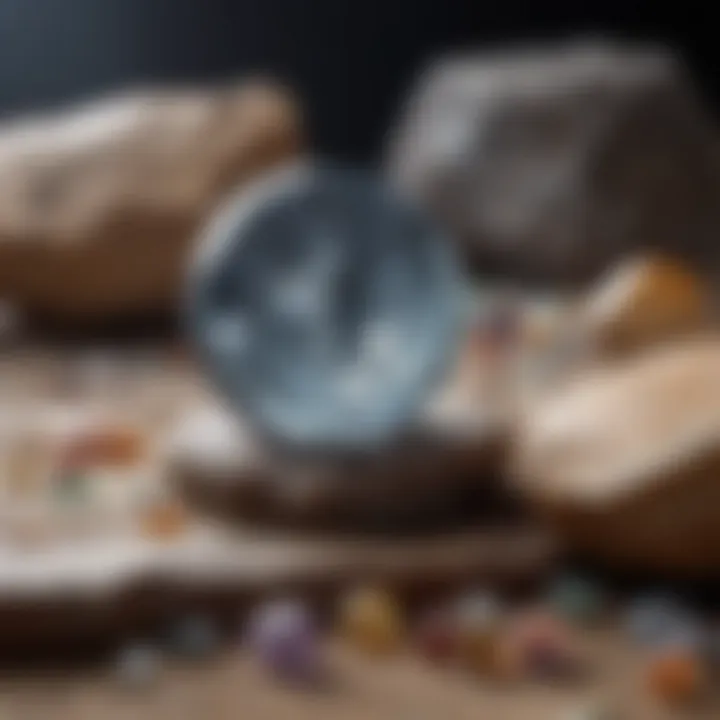
When it comes to the world of gemstones, advanced gemological assessments play a crucial role in determining the authenticity and quality of these precious stones. Unlike simple visual inspections, these assessments use specialized tools and scientific methods to analyze gemstones on a deeper level. A key benefit of advanced assessments is that they not only help in distinguishing between natural and synthetic stones but also provide insights into the stone's history, treatment, and inherent qualities. For collectors and enthusiasts, having this information is invaluable in making informed purchasing decisions.
Gemology Tools and Equipment
In the realm of gemology, tools are more than just instruments; they are indispensable for accurate analysis. Different tools specialize in various aspects of gemstone assessment, each contributing uniquely to the overall understanding of a gemstone's characteristics.
Refractometer
The refractometer is one of the essential tools in gemology. It assesses the refractive index of a gemstone, an important parameter that helps identify the material. A noteworthy characteristic of refractometers is their precision; they can differentiate between stones with similar appearances and properties. This capability makes them a popular choice among gemologists, as even slight variations in refractive index can indicate whether a stone is genuine or an imitation.
Unique feature: Refractometers often come equipped with a built-in thermometer, allowing for accurate readings that account for temperature changes. Advantages: Precision and relatively easy use in field assessments. Disadvantages: Limited to refractive index readings; it does not provide a comprehensive analysis alone.
Spectroscope
The spectroscope is another vital tool in a gemologist's arsenal. This device analyzes the spectrum of light that passes through a gemstone. The unique absorption and transmission patterns can reveal the stone's chemical composition and identify specific inclusions. Its notable characteristic is the ability to uncover hidden details that might not be visible to the naked eye, making it essential for detailed examinations.
Unique feature: Some spectroscopes come with the capability to take digital readings, allowing for easier record-keeping and analysis.
Advantages: Provides a wealth of information beyond basic visual inspections; can detect treatments and enhancements.
Disadvantages: Requires expertise to interpret the results correctly; not as portable as other tools.
Microscope
Gemologists often rely on a microscope for intricate examinations. It offers a detailed view of inclusions and surface characteristics that are crucial in defining a gemstone's authenticity. The clarity and magnification capabilities allow for a deeper investigation, which is particularly beneficial in distinguishing natural gems from their synthetic cousins.
Unique feature: Modern gemological microscopes frequently have built-in lighting and magnification adjustments for optimal viewing.
Advantages: Provides extremely detailed insights into the stone's internal structure; essential for evaluating clarity and cut quality.
Disadvantages: Its bulk can limit field use; requires steady hands for practical application.
Spectral Analysis Techniques
Spectral analysis takes the examination of gemstones a step further. By measuring how a stone interacts with light, gemologists can determine more than just its identity. They can ascertain its origin, authenticity, and even previous treatments used.
Oftentimes, gemologists employ advanced spectral techniques, such as infrared spectroscopy and raman spectroscopy. Each method has its strengths and applications, which can offer additional layers of information.
In essence, the realm of advanced gemological assessments embraces a world where knowledge intersects with science. This can empower rock and fossil collectors with the understanding they need to confidently navigate the intricate web of gemstone authenticity. With the right tools in hand and a solid grasp of these advanced techniques, one can build a foundation of knowledge that is not only valuable but indispensable.
Reading Certifications
Understanding gemstone certifications is essential for anyone looking to navigate the complex world of gemstone authenticity. A certification can be a game-changer, offering insights that an untrained eye might overlook. When you know what to look for in these documents, it can significantly bolster your confidence in the purchase you are making.
Key Elements of Gemstone Certifications
Certifications provide a detailed report of a stone's characteristics. This often includes:
- Type of Gemstone: The specific kind of stone you are looking at, whether it’s a diamond, emerald, or sapphire.
- Cut and Clarity: The quality of the cut and clarity, which influence both aesthetic appeal and value.
- Color Grade: A description of the color quality, which impacts desirability.
- Carat Weight: The size of the gemstone, indicating its weight and size.
- Inclusions: Any natural flaws found in the stone that can affect its beauty and value.
Benefits of Reading Certifications
Reading these reports equips collectors with knowledge that transcends mere aesthetics. It allows for a deeper understanding of the stone, often revealing more than what is visible to the naked eye. Moreover, it aids in:
- Making Informed Decisions: A gemstone with a reputable certification often is a good investment, whereas one without might be a risk.
- Avoiding Counterfeits: By knowing what's genuine, you can avoid those imitations that abound in the market.
- Establishing Value: A certification lends credibility and helps set a fair market price, preventing you from overpaying.
"A certification is your stone’s resume—providing proof of its attributes and history."
Understanding Gemstone Reports
Gemstone reports are comprehensive documents that ultimately illustrate a stone’s authenticity. These reports are usually generated by reputable laboratories and can vary in detail.
What should you look for in a gemstone report?
- Lab Name: Ensure it’s from a well-known and respected entity.
- Methods Used: The techniques employed to analyze the gemstone should be clearly outlined. You want transparency in the methods.
- Date of Report: A recent report might better serve current market conditions than one created several years ago.
- Identification Number: A unique ID that can locate the report in the lab's database gives added security.
Reputable Certification Bodies
Not all certification labs are created equal. Some have established a solid reputation over time, while others may lack the rigor necessary for credibility. Among the top-tier bodies are:
- Gemological Institute of America (GIA): Renowned for its strict grading standards, GIA certifications are respected globally.
- American Gem Society (AGS): This organization offers evaluations focusing extensively on cut quality, especially for diamonds.
- International Gemological Institute (IGI): Known for its detailed reports and a focus on consumer education.
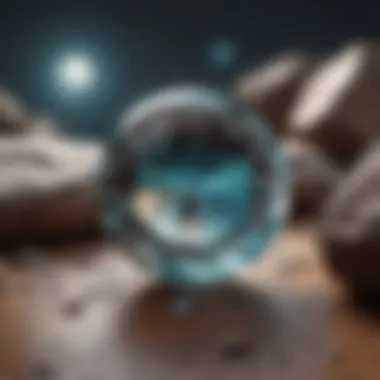

When investing in gemstones, consider the certifications provided by these organizations. They offer not just assurance but also potentially higher resale values down the line.
Being well-versed in the nuances of gemstone certifications can elevate your collecting experience from casual to expert. This knowledge keeps you ahead of potential pitfalls and positions you to better appreciate the beauty and value of your gemstones.
Recognizing Common Imitations
Understanding how to recognize common imitations is crucial for anyone involved in the world of gemstones. Knowing the difference between genuine stones and their counterparts not only protects one’s investment but also enhances the overall appreciation of these natural wonders. The vast array of imitated stones, from synthetic variants to cleverly disguised fakes, can easily mislead the inexperienced eye. Identifying these imitations can save you from costly mistakes and ensure your collection remains authentic.
Synthetic vs. Natural Gemstones
The conversation around synthetic versus natural gemstones is a hot topic among collectors. On one hand, you have natural gemstones like sapphires and emeralds, formed over millions of years within the Earth’s crust. Their journey through geological processes lets them hold a history of the world. On the other side, synthetic gemstones, such as lab-created rubies, offer perfect clarity and color consistency, mimicking natural stones without the unique characteristics that come from the Earth.
Here are some important aspects to consider:
- Origin: Natural stones have a unique formation process, while synthetic stones are manufactured. This leads to differences in price and value.
- Visual Clues: Often, you'll notice that synthetic gemstones appear too perfect. Natural stones usually have small imperfections or inclusions.
- Market Value: Natural gems tend to retain or appreciate in value, while synthetic stones often have lower resale values.
In essence, recognizing the origin of a gemstone is paramount. A trained eye can spot the subtle differences, making it essential for serious collectors to gain knowledge about both categories.
Common Imitation Materials
With advancements in technology, imitation materials have become a lot more convincing. Recognizing them is vital to ensure the integrity of your collection. Some common imitation materials include:
- Cubic Zirconia (CZ): Often used as a diamond substitute, CZ has excellent clarity and shine, yet it lacks the natural imperfections found in real diamonds.
- Moissanite: This lab-created gemstone resembles diamonds closely but is generally denser and has a distinct sparkle.
- Glass: Fake gems made from glass can be colored to look like genuine stones. Look for bubbles inside the stone, which indicate it’s man-made.
- Synthetic Quartz: Mimics the appearance of natural quartz and comes in various colors but can sometimes lack the depth and uniqueness found in genuine quartz.
- Doublets: These are assembled stones made from two layers, one being genuine stone and the other a less expensive material. This technique tries to enhance the color and appearance.
Always remember, if the price seems too good to be true, it probably is.
Recognizing these materials not only requires visual inspections but sometimes even testing methods to verify compositions. The more aware you are of imitations, the better equipped you'll be to make informed purchases.
In summary, recognizing common imitations is about understanding the nuances of gemstone properties and the market realities. Knowledge is your best ally in this realm.
Market Dynamics and Value Assessment
Understanding the market dynamics surrounding gemstones is essential for anyone looking to navigate this intricate field, especially collectors and investors. Gemstones are not merely decorative items; they are commodities that function within a complex web of supply and demand. Factors such as rarity, quality, and market trends play a crucial role in determining their value. Recognizing these dynamics is key for making informed purchasing decisions and for ensuring that your investments appreciate over time.
Factors Influencing Gemstone Value
The valuation of a gemstone is influenced by several critical factors:
- Quality of the stone: This includes the gem's color, clarity, cut, and carat weight—all fundamental criteria in gemstone grading. An emerald with a rich green hue and minimal inclusions will command a higher price than a paler specimen with many visible flaws.
- Rarity: Certain gemstones, like painite or blue garnet, are exceptionally rare. Their scarcity dramatically increases their value, especially among collectors who appreciate unique pieces in their collections.
- Origin: The geographical origin of a gemstone can greatly influence its value. For instance, Burmese rubies and Kashmir sapphires are often valued higher than stones from other locations because of their historical significance and quality associated with their respective deposits.
- Market Demand: Trends within the gemstone market can fluctuate based on fashion, culture, and consumer preferences. For example, a surge in popularity for specific colors or types, often influenced by celebrities or fashion icons, can result in rapid price increases.
- Condition: A gem’s physical state—whether it has been properly maintained or shows signs of wear—can also affect its overall value. An antique piece in excellent condition is a much rarer find than one that shows significant damage or restoration.
Market Trends and Pricing
Gemstone pricing is subject to various market trends that are worth monitoring. Understanding these trends can provide insights into future values and help inform purchasing strategies:
- Seasonal Trends: Many collectors notice peaks in demand during certain seasons. For example, spring and summer often bring an increase in wedding-related purchases, such as engagement rings or gifts, which can drive up prices for certain stones.
- Economic Factors: Just like any other investment, gemstones are influenced by wider economic conditions. In prosperous times, people tend to spend more on luxury items, including jewelry featuring precious stones. Conversely, during economic downturns, the demand might dip.
- Technological Advances: New gemology tools and techniques allow for better identification and grading of stones, influencing their market perception. A gemstone that can be confidently graded as authentic by a reputable source tends to have a better market standing.
- Social Media Influence: Platforms like Instagram and Pinterest have reshaped how gemstones are marketed. A viral trend can lead to an abrupt surge in interest for specific stones, impacting their pricing significantly.
- The Ethical Consideration Movement: As consumers become increasingly mindful about ethical sourcing, gemstones that come with a certification of ethical origin tend to be more sought after and can command higher prices.
By understanding the market dynamics and being aware of trending factors, collectors can strategically position themselves in the gemstone market. Investing in education and ongoing research into these elements can greatly enhance a collector's acumen and lead to more rewarding experiences.
Final Thoughts
In the complex world of gemstones, knowing how to determine authenticity is paramount. It’s not just about wearing a beautiful piece of jewelry; it’s about understanding the story and value behind each gem. Every collector or enthusiast—whether you’ve just started or have amassed a collection—needs to grasp the significance of mastering these evaluation techniques. The final thoughts in this article encapsulate the journey we’ve taken through various methods for assessing gemstones, marrying theoretical knowledge with practical skills.
Building Your Knowledgebase
Building a strong knowledge base about gemstones involves several layers. One must start with the fundamentals: what makes a gemstone genuine? Engaging deeply into this topic amalgamates various aspects such as the properties of natural stones, historical contexts, and the science behind gemstone formation.
- Research: Allocate time to read gemological texts and articles. Books by esteemed authors on gemology are goldmines of information. Consider works from Richard T. Liddicoat, who is often referred to as the "father of modern gemology."
- Join Communities: Platforms like Reddit or specialized forums can be rich sources for obtaining real-life insights from fellow gemstones aficionados. If you want to share experiences and learn, these communities can provide invaluable support.
- Hands-On Experience: Try visiting gem shows or local merchants. Getting your hands on gemstones allows for practical learning. As the proverb goes, "Seeing is believing."
Knowledge building should be a continuous process. Each gemstone tells its own tale, and as you immerse yourself in their unique characteristics, your ability to recognize authenticity will grow significantly.
Continuing Education and Resources
The quest for authenticating gemstones doesn't end with basic awareness; it requires an ever-evolving understanding. Continuous education is vital in staying informed about the latest developments in gemology and market trends. Here’s how to do it effectively:
- Enroll in Courses: Look for gemology courses provided by credible institutions such as the Gemological Institute of America (GIA). Their certification courses offer structured learning tailored for enthusiasts wanting professional insights.
- Attend Workshops: Many local gem and mineral clubs offer workshops or seminars. Participating in these can supplement your education with practical skills under the guidance of industry experts.
- Utilize Online Resources: Websites like Wikipedia, Wikipedia's gemology section, or Britannica provide a wealth of foundational knowledge. Don’t overlook the various educational videos available on platforms such as Facebook or YouTube.
- Networking: Connect with gemologists and jewelers. Building relationships in the industry can grant you access to exclusive insights and professional evaluations.
Ultimately, by staying thoroughly engaged and frequently updating your knowledge, you will enhance your ability to discern genuine gemstones from imitations. In this dynamic field, every piece of information can be the difference between a mistake and an informed choice in your collection.



